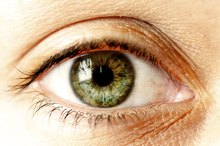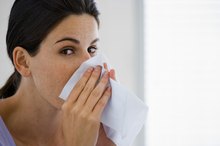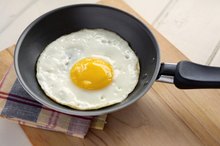Which Vitamins Help Sinus & Allergies?
Some vitamins may help boost the immune system and reduce the severity of sinus problems and allergies. Sinusitis is the swelling of the nasal sinuses and typically occurs from a cold or infection, says the American Academy of Allergy, Asthma and Immunology. Allergies can also cause sinus problems because of the swelling that occurs when exposed to allergens. Vitamins can't cure or completely prevent allergies or sinus problems, and talking to a health care professional about vitamin supplements can provide more information about which vitamins are best for your immune system.
Vitamin E
Vitamin E is a fat-soluble vitamin that's also an antioxidant. According to the University of Maryland Medical Center, antioxidants help protect cells from damage caused by free radicals that can cause disease. It also helps the body produce red blood cells and aids the body in utilizing vitamin K. The Mayo Clinic says vitamin E may help reduce nasal allergies, but more studies must be performed before a definitive association can be established. Foods containing vitamin E include eggs, sunflower seeds, nuts, dark green leafy vegetables and asparagus.
- Vitamin E is a fat-soluble vitamin that's also an antioxidant.
- It also helps the body produce red blood cells and aids the body in utilizing vitamin K. The Mayo Clinic says vitamin E may help reduce nasal allergies, but more studies must be performed before a definitive association can be established.
Vitamin C
How Much Vitamin C for a Sinus Infection?
Learn More
Vitamin C is typically thought of as a vitamin that helps boost the immune system, but this vitamin has other functions as well. This vitamin is used in the synthesis of collagen and the neurotransmitter norepinephrine, as well as functioning as an antioxidant, says the Linus Pauling Institute. Although studies are conflicting, vitamin C may also help stimulate production of white blood cells, which help fight bacteria and infections. The Mayo Clinic says vitamin C may reduce the duration of colds in some people, but more research needs to be done. Dietary sources of this vitamin include citrus fruits, broccoli, cooked leafy greens and potatoes.
- Vitamin C is typically thought of as a vitamin that helps boost the immune system, but this vitamin has other functions as well.
- Although studies are conflicting, vitamin C may also help stimulate production of white blood cells, which help fight bacteria and infections.
Vitamin A
Vitamin A is a group of compounds, some of which function as antioxidants. Vitamin A helps promote healthy mucous membranes, which help keep bacteria out of the body. The vitamin also helps regulate the immune system by stimulating white blood cell production, says the National Institutes of Health Office of Dietary Supplements. There are two types of vitamin A, depending on whether the dietary source is an animal product or plant product, says the Office of Dietary Supplements. Good sources of this vitamin include fortified milk, liver, cheese, carrots, spinach, oatmeal and kale.
- Vitamin A is a group of compounds, some of which function as antioxidants.
- The vitamin also helps regulate the immune system by stimulating white blood cell production, says the National Institutes of Health Office of Dietary Supplements.
Zinc
Can Vitamins Prevent the Flu?
Learn More
Zinc is a mineral that may be naturally found or added to foods, and is also available as a supplement. Zinc plays a role in immune function, wound healing, protein synthesis, the senses of taste and smell, and normal growth and development. The Office of Dietary Supplements describes zinc as possibly reducing inflammation in the nasal mucosa, but there are no data to prove this. Zinc has been shown to shorten cold symptoms, including nasal discharge, but more studies need to be performed. Dietary sources include oysters, beef shanks, chicken legs, lobster, pork shoulder and cashews.
- Zinc is a mineral that may be naturally found or added to foods, and is also available as a supplement.
- The Office of Dietary Supplements describes zinc as possibly reducing inflammation in the nasal mucosa, but there are no data to prove this.
Related Articles
References
- Linus Pauling Institute at Oregon State University: Vitamin C
- National Institutes of Health Office of Dietary Supplements: Vitamin A and Carotenoids
- Bruno, R. S., Leonard, S. W., Atkinson, J., Montine, T. J., Ramakrishnan, R., Bray, T. M., & Traber, M. G. (2006). Faster plasma vitamin E disappearance in smokers is normalized by vitamin C supplementation. Free Radical Biology and Medicine, 40(4), 689-697. .
- Davey, M. W., Montagu, M. V., Inzé, D., Sanmartin, M., Kanellis, A., Smirnoff, N., ... & Fletcher, J. (2000). Plant Lâascorbic acid: chemistry, function, metabolism, bioavailability and effects of processing. Journal of the Science of Food and Agriculture, 80(7), 825-860.
- Alessio, H. M., Hagerman, A. E., Fulkerson, B. K., Ambrose, J. E. S. S. I. C. A., Rice, R. E., & Wiley, R. L. (2000). Generation of reactive oxygen species after exhaustive aerobic and isometric exercise. Medicine and Science in Sports and Exercise, 32(9), 1576-1581.
- Padayatty, S. J., Katz, A., Wang, Y., Eck, P., Kwon, O., Lee, J. H., ... & Levine, M. (2003). Vitamin C as an antioxidant: evaluation of its role in disease prevention. Journal of the American College of Nutrition, 22(1), 18-35.
- Bendich, A., & Langseth, L. (1995). The health effects of vitamin C supplementation: a review. Journal of the American College of Nutrition, 14(2), 124-136.
- Douglas, R. M., & Hemilä, H. (2005). Vitamin C for preventing and treating the common cold. PLoS Medicine, 2(6), e168.
- Bryer, S. C., & Goldfarb, A. H. (2006). Effect of high dose vitamin C supplementation on muscle soreness, damage, function, and oxidative stress to eccentric exercise. International Journal of Sport Nutrition and Exercise Metabolism, 16(3), 270-280.
- Nakhostin-Roohi, B., Babaei, P., Rahmani-Nia, F., & Bohlooli, S. (2008). Effect of vitamin C supplementation on lipid peroxidation, muscle damage and inflammation after 30-min exercise at 75% VO^ sub 2max^. Journal of Sports Medicine and Physical Fitness, 48(2), 217.
- Li, H., Zou, Y., & Ding, G. (2012). Dietary factors associated with dental erosion: a meta-analysis. PloS One, 7(8), e42626.
- Moertel, C. G., Fleming, T. R., Creagan, E. T., Rubin, J., O'Connell, M. J., & Ames, M. M. (1985). High-dose vitamin C versus placebo in the treatment of patients with advanced cancer who have had no prior chemotherapy: a randomized double-blind comparison. New England Journal of Medicine, 312(3), 137-141.
- Bruno, R. S., Leonard, S. W., Atkinson, J., Montine, T. J., Ramakrishnan, R., Bray, T. M., & Traber, M. G. (2006). Faster plasma vitamin E disappearance in smokers is normalized by vitamin C supplementation. Free Radical Biology and Medicine, 40(4), 689-697.
- Huang, J., & May, J. M. (2003). Ascorbic acid spares α-tocopherol and prevents lipid peroxidation in cultured H4IIE liver cells. Molecular and Cellular Biochemistry, 247(1), 171-176.
- Kalgaonkar, S., & Lönnerdal, B. (2008). Effects of dietary factors on iron uptake from ferritin by Caco-2 cells. The Journal of Nutritional Biochemistry, 19(1), 33-39.
- Monsen, E. R. (2000). Dietary reference intakes for the antioxidant nutrients: vitamin C, vitamin E, selenium, and carotenoids. Journal of the American Dietetic Association, 100(6), 637-640.
Resources
Writer Bio
Jaime Herndon has been writing for health websites since 2009 and has guest-blogged on SheKnows. After graduating with a Bachelor of Arts in psychology and women's studies, she earned a Master of Science in clinical health psychology and a Master of Public Health in maternal-child health. Her interests include oncology, women's health and exercise science.









